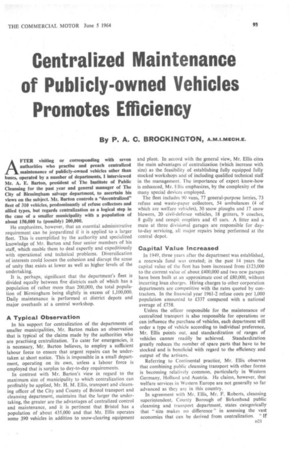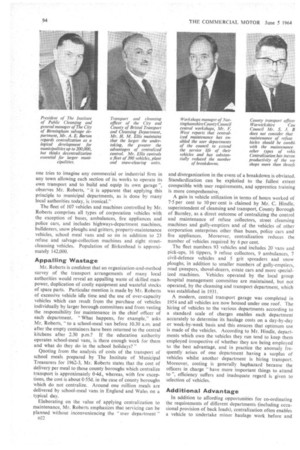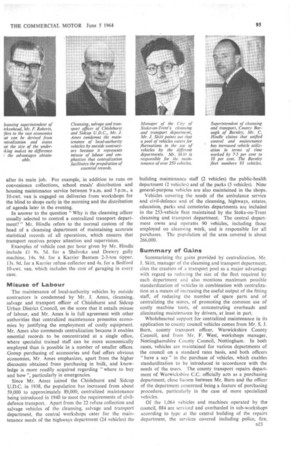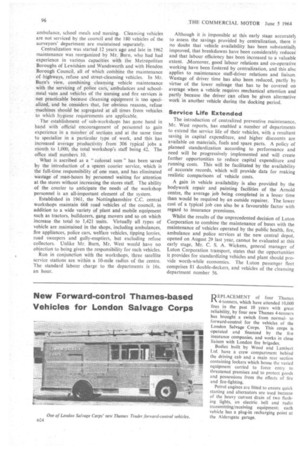Centralized Maintenance of Publicly-owned Vehicles Promotes Efficiency
Page 95

Page 96

Page 97

Page 98

If you've noticed an error in this article please click here to report it so we can fix it.
By P. A. C. BROCKINGTON, A.M.I.MECH.E.
AFTER visiting or corresponding with seven authorities who practise and preach centralized maintenance of publicly-owned vehicles other than buses, operated by a number of departments, I interviewed Mr. A. E. Barton, president of The Institute of Public Cleansing for the past year and general manager of The City of Birmingham salvage department, to ascertain his views on the subject. Mr. Barton controls a "decentralized" fleet of 310 vehicles, predominantly of refuse collectors and allied types, but regards centralization as a logical step in the case of a smaller municipality with a population of about 150,000 to (possibly) 200,000.
He emphasizes, however, that an essential administrative requirement can be jeopardized if it is applied to a larger fleet. This is exemplified by the authority and specialized knowledge of Mr. Barton and four senior members of his staff, which enable them to deal expertly and expeditiously with operational and technical problems. Diversification of interests could loosen the cohesion and disrupt the sense of unity that exists at lower as well as higher levels of the undertaking. It is, perhaps, significant that the department's fleet is divided equally between five districts each of which has a population of rather more than 200,000, the total population of Birmingham being slightly in excess of 1,100,000. Daily maintenance is performed at district depots and major overhauls at' a central workshop.
A Typical Observation
In his support for centralization of the departments of smaller municipalities, Mr. Barton makes an observation that is typical of the claims made by the authorities who are practising centralization. To cater for emergencies, it is necessary, Mr. Barton believes, to employ a sufficient labour force to ensure that urgent repairs can be undertaken at short notice. This is impossible in a small department, operating on its own, unless a labour force is employed that is surplus to day-to-day requirements.
In contrast with Mr. Barton's view in regard to the maximum size of municipality to which centralization can profitably be applied, Mr. H. M. Ellis, transport and cleansing officer of the City and County of Bristol transport and cleansing department, maintains that the larger the undertaking, the greater are the advantages of centralized control and maintenance, arid it is pertinent that Bristol has a population of about 435,000 and that Mr. Ellis operates some 390 vehicles in addition to snow-clearing equipment and plant. In accord with the general view, Mr. Ellis cites the main advantages of centralization (which increase with size) as the feasibility of establishing fully equipped fully stocked workshops and of including qualified technical staff in the management. The importance of expert know-how is enhanced, Mr. Ellis emphasizes, by the complexity of the many special devices employed.
The fleet includes 90 vans, 77 general-purpose lorries, 73 refuse and waste-paper collectors, 54 ambulances (4 of which are welfare vehicles), 30 snow ploughs and 17 snow blowers, 20 civil-defence vehicles, 18 gritters, 9 coaches, 8 gully and cesspit emptiers and 45 cars. A fitter and a mate at three divisional garages are responsible for dayto-day servicing, all major repairs being performed at the central depot.
Capital Value Increased In 1949, three years after the department was established, a renewals fund was created; in the past 14 years the capital value of the fleet has been increased from £123,000 to the current value of about £400,000 and two new garages have been built at an approximate cost of £80,000, without incurring loan charges. Hiring charges to other corporation departments are competitive with the rates quoted by contractors. In the financial year 1961-2 refuse costs per 1,000 population amounted to £337 compared with a national average of £758.
Unless the officer responsible for the maintenance of centralized transport is also responsible for operations or can influence the purchase of vehicles, each department will order a type of vehicle according to individual preference, Mr. Ellis points out, and standardization of ranges of
vehicles cannot readily be achieved. Standardization greatly reduces the number of spare parts that have to be stocked and is beneficial with regard to the efficiency and output of the artisans.
Referring to Continental practice, Mr. Ellis observes that combining public cleansing transport with other forms is becoming relatively common, particularly in Western Germany, Holland and Austria. He claims, however, that welfare services in Western Europe are not generally so far advanced as they are in this country.
In agreement with Mr, Ellis, Mr. F. Roberts, cleansing superintendent, County Borough of Birkenhead public cleansing and transport department, states categorically that " size makes no difference" in assessing the vast economies that can be derived from centralization. "If
one tries to imagine any commercial or industrial firm in any town allowing each section of its works to operate its own transport and to build and equip its own garage ", observes Mr. Roberts, it is apparent that applying this principle to municipal departments, as is done by many local authorities today, is ironical."
The fleet of 107 vehicles and machines controlled by Mr. Roberts comprises all types of corporation vehicles with the exception of buses, ambulances, fire appliances and police cars, and includes highways-department machines, bulldozers, snow ploughs and gritters, property-maintenance vehicles, school meal vans and so on in addition to 23 refuse and salvage-collection machines and eight streetcleansing vehicles. Population of Birkenhead is approximately 142,000.
Appalling Wastage
Mr. Roberts is confident that an organization-and-method survey of the transport arrangements of many local authorities would reveal an appalling waste of skilled manpower, duplication of costly equipment and wasteful stocks of spare parts. Particular mention is made by Mr. Roberts of excessive vehicle idle time and the use of over-capacity vehicles which can result from the purchase of vehicles individually by larger borough committees and from vesting the responsibility for maintenance in the chief officer of each department. "What happens, for example," asks Mr. Roberts, "to a school-meal van before 10.30 a.m. and after the empty containers have been returned to the central kitchens after 2.30 p.m.? If the education authority operates school-meal vans, is there enough work for them and what do they do in the school holidays?"
Quoting from the analysis of costs of the transport of school meals prepared by The Institute of Municipal Treasurers for 1962-3, Mr. Roberts states that the cost of delivery per meal to those county boroughs which centralize transport is approximately 04d., whereas, with few exceptions, the cost is about 0-55d. in the case of county boroughs which do not centralize. Around one million meals are delivered by school-meal vans in England and Wales on a typical day.
Elaborating on the value of applying centralization to maintenance, Mr. Roberts emphasizes that servicing can be planned without inconveniencing the "user department
132.1
and disorganization in the event of a breakdown is obviated. Standardization can be exploited to the fullest extent compatible with user requirements, and apprentice training is more comprehensive.
A gain in vehicle utilization in terms of hours worked of 7.5 per cent to 10 per cent is claimed by Mr. C. Hindle, superintendent of cleansing and transport, County Borough of Burnley, as a direct outcome of centralizing the control and maintenance of refuse collectors, street cleansing machines and gully-emptiers and of the vehicles of other corporation enterprises other than buses, police cars and fire appliances. Moreover, centralization reduces the number of vehicles required by 6 per cent.
The fleet numbers 93 vehicles and includes 20vans and pick-ups, 16 tippers, 9 refuse collectors, 9 ambulances, 7 civil-defence vehicles and 5 grit spreaders and snow ploughs, in addition to smaller numbers of gully-emptiers, road weepers, shovel-dozers, estate cars and more specialized machines. Vehicles operated by the local group hospital management committee are maintained, but not operated, by the cleansing and transport department, which was established in 1931.
A modern, central transport garage was completed in 1954 and all vehicles are now housed under one roof. The hiring of vehicles to the various departments according to a standard scale of charges enables each department accurately to determine its haulage costs on a day-by-day or week-by-week basis and this ensures that optimum use is made of the vehicles. According to Mr. Hindle, departments which own the vehicles they run tend to keep them employed irrespective of whether they are being employed to the best advantage, and in practice the anomaly frequently arises of one department having a surplus of vehicles whilst another department is hiring transport. Moreover, costing is generally haphazard because the officers in charge "have more important things to attend to ", efficiency suffers and inadequate regard is given to selection of vehicles.
Additional Advantage
In addition to affording opportunities for co-ordinating the requirements of different departments (including occasional provision of back loads), centralization often enables a vehicle to undertake minor haulage work before and after its main job. For example, in addition to runs on convenience collections, school meals' distribution and housing maintenance service between 9 a.m. and 5 p.m., a 10-cwt. van is engaged on deliveries from workshops for the blind to shops early in the morning and the distribution of agenda later in the evening.
In answer to the question "Why is the cleansing officer usually selected to control a centralized transport department?" Mr. Hindle refers to the normal custom of the head of a cleansing department of maintaining accurate statistical records of all operations, which ensures that transport receives proper attention and supervision.
Examples of vehicle cost per hour given by Mr. Hindle include £1 9s. 5d. for a Shelvoke and Drewry gully machine, 14s. 9d. for a Karrier Bantam 2-3-ton tipper, 13s. 9d. for a Karrier refuse collector and 4s. for a Bedford 1d-cwt. van, which includes the cost of garaging in every case.
Misuse of Labour The maintenance of local-authority vehicles by outside contractors is, condemned by Mr. J. Ames, cleansing, salvage and transport officer of Chislehurst and Sidcup Urban District Council, on the score that it entails misuse of labour, and Mr. Ames is in full agreement with other authorities that centralized maintenance promotes economies by justifying the employment of costly equipment. Mr. Ames also commends centralization because it enables essential records to be concentrated at a single office, where specialist trained staff can be more economically employed than is possible in a number of smaller offices. Group purchasing of accessories and fuel offers obvious economies, Mr. Ames emphasizes, apart from the higher discounts obtained from purchasing in bulk, and knowledge is more readily acquired regarding "where to buy and how ", particularly in emergencies.
Since Mr. Ames joined the Chislehurst and Sidcup U.D.C. in 1938, the population has increased from about 59,000 to approximately 89,000, centralized maintenance being introduced in 1940 to meet the requirements of civildefence transport, Apart from the 22 refuse collection and salvage vehicles of the cleansing, salvage and transport department, the central workshops cater for the maintenance needs of the highways department (24 vehicles) the building maintenance staff (2 vehicles) the public-health department (2 vehicles) and of the parks (5 vehicles). Nine general-purpose vehicles are also maintained in the shops.
Vehicles covering the needs of the ambulance service and civil-defence and of the cleansing, highways, estates, education, parks and cemeteries departments are included in the 253-vehicle fleet maintained by the Stoke-on-Trent cleansing and transport department. The central department owns and operates 90 vehicles, including those employed on cleansing work, and is responsible for all purchases. The population of the area covered is about 266,000.
Summary of Gains
Summarizing the gains provided by centralization, Mr. J. Skitt, manager of the cleansing and transport department, cites the creation of a transport pool as a major advantage with regard to reducing the size of the fleet required by each department and also mentions maximum possible standardization of vehicles in combination with centralization as a means of increasing the useful output of the fitting staff, of reducing the number of spare parts and of centralizing the stores, of promoting the common use of costly machine tools, of concentrating overheads and eliminating maintenance by drivers, at least in part.
Wholehearted support for centralized maintenance in its application to county council vehicles comes from Mr. S. J. Burn, county transport officer, Warwickshire County Council, and from Mr. F. West, workshops manager, Nottinghamshire County Council, Nottingham. In both cases, vehicles are maintained for various departments of the council on a standard rates basis, and both officers "have a say" in the purchase of vehicles, which enables standardization to be introduced in /accordance with the needs of the users. The county transport repairs department of Warwickshire C.C. officially acts as a purchasing department, close liaison between Mr. Burn and the officer of the department concerned being a feature of purchasing procedure, particularly in the case of more specialized vehicles.
Of the 1,064 vehicles and machines operated by the council, 884 are serviced and overhauled in sub-workshops according to type at the central building of the repairs department, the services covered including police, fire, ambulance, school meals and nursing. Cleansing vehicles are not serviced by the council and the 180 vehicles of the surveyors' department are maintained separately.
Centralization was started 12 years ago and late in 1962 maintenance was reorganized by Mr. Burn, who had had experience in various capacities with the Metropolitan Boroughs of Lewishiim and Wandsworth and with Hendon Borough Council, all of which coMbine the maintenance of highways, refuse and street-cleansing vehicles. In Mr. Burn's view, combining cleansing vehicle maintenance with the servicing of police cars,' ambulatices and schoolmeal vans and vehicles of the nursing and fire services is not practicable because cleansing equipment is too specialized, and he considers that, for obvious reasons, refuse machines should be segregated at all times from vehicles to which hygiene requirements are applicable.
The establishment .of 'sub-workshops has gone hand in hand with official encouragement of personnel to gain experience in a number of sections and at the same time to specialize in a particular type of work, and this has increased average productivity from 306 typical jobs a Month to 1,000, the total workshop's staff being 42. The office staff numbers 10.
. What is ascribed as a "colossal sum" has been saved by the introduction of a spares courier service, which is the full-time responsibility of one man, and has eliminated Wastage of man-hours by personnel waiting for attention at the stores without increasing the stores staff. The ability of the courier to anticipate the needs of the workshop personnel is an all-important element of the system.
Established in 1961, the Nottinghamshire C.C. central workshops maintain 668 road vehicles of the council, in addition to a wide variety of plant and mobile equipment such as tractors, bulldozers, gang movers and so on which increase the total to 1,421 units. Virtually all types of vehicle are maintained in the shops, including ambulances, fire appliances, police cars, welfare vehicles, tipping lorries, road sweepers and gully-emptiers, but excluding refuse collectors. Unlike Mr. Burn, Mr. West would have no objection to being given the responsibility for such vehicles.
Run in conjunction with the workshops, three satellite service stations are within a 10-mile radius of the centre. The standard labour charge to the departments is 16s. an hour. Although it is impossible at this early stage accurately to assess the savings provided by centralization, there i!
no doubt that vehicle availability has been substantially improved, that breakdowns have been considerably reducer and that labour efficiency has been increased to a valuable extent. -Moreover, good labour relations and co-operative working have been fostered by centralization, and this also applies to maintenance staff-driver relations .and liaison. Wastage of driver time has also been reduced, partly by virtue of the lower mileage that has to be covered on average when a vehicle requires mechanical attention and partly because the driver can often be given alternative work in another vehicle during the docking period.
Service Life Extended
The introduction of centralized preventive maintenance, Mr. West reports, has enabled a number of departments to extend the service life of their vehicles, with a resultant saving in capital expenditure, and higher discounts are available on materials, fuels and spare parts. A policy of planned standardization according to performance and need will be progressively implemented and will create further opportunities to reduce capital expenditure and running costs. This will be facilitated by the availability of accurate records, which will provide data for making realistic comparisons of vehicle costs.
A gain in vehicle availability is also provided by the bodywork repair and painting facilities of the Arnold centre, the average job being completed in a lesser time than would be required by an outside repairer. The lower cost of a typical job can also be a favourable factor with regard to insurance premiums.
Whilst the results of the unprecedented decision of Luton Corporation to combine the maintenance of buses with the maintenance of vehicles operated by the public health, fire, ambulance and police services at the new central depot, opened on August 29 last year, cannot be evaluated at this early stage, Mr. C. S. A. Wickens, general manager of Luton Corporation transport, states that the opportunities it provides for standardizing vehicles and plant should provide worth-while economies. The Luton passenger fleet comprises 81 double-deckers, and vehicles of the cleansing department number 56.












































































































































































